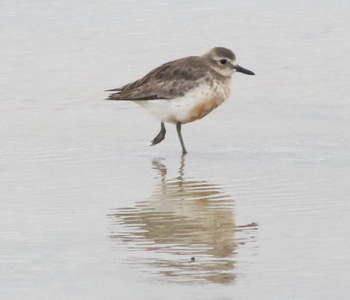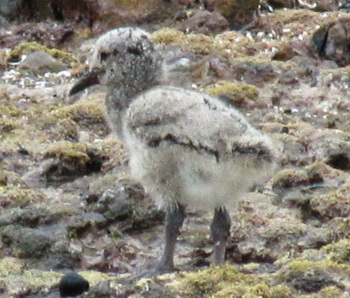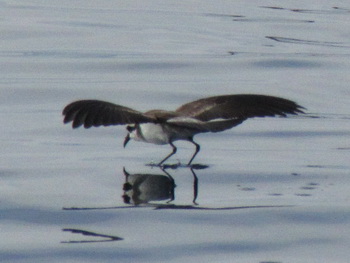Sea & Shore Birds
of New Zealand
| |
| HOME |
| About Tenaya |
| About Us |
| Latest Update |
| Logs from Current Year |
| Logs from Previous Years |
| Katie's View |
| Route Map |
| Links |
| Contact Us |
![]()
There are so many unusual and beautiful birds in New Zealand that we've separated them by where they are most likely to be found, land or water, and made a page for each. Those that are found on lakes, rivers, estuaries, saltmarshes, swamps, along the shore and at sea are shown on this page.


Yellow-Eyed Penguin - Curio Bay
Native, found only in New Zealand. Endangered and one of the rarest penguins in the world. Unlike most penguins that live in colonies, among rocks or on snow and ice, pairs of yellow-eyed penguins prefer secluded forest and scrub to nest. They leave each morning at dawn to fish and return to the shore in late afternoon. Their yellow eyes enable them to see as they dive 40-90 meters in search of squid, red and blue cod. Can live 25 years.


Fiordland Crested Penguin - Ulva Island (moulting), Breaksea Sound (swimming)
Rare. Found only in New Zealand. Smaller than yellow-eyed penguin. Breeds and moults in dense coastal forest or in caves on rocky shores of southern NZ.

Blue Penguin - outside Whangaroa Harbour
Native. Common. Named for the blue-black color on the bird's back. The world's smallest penguin and NZ's most common penguin. The only penguin to breed on the North Island coasts. Hunts small squid, fish and octopus. Spends most of the year at sea but often comes ashore at night to rest. In August they come ashore to breed in burrows, caves, under driftwood and even under beach cottages. They usually nest near the coast but can travel a kilometer or more inland. Road signs warn motorists to watch out at night for birds crossing the road to reach their nests. Our books say they are usually spotted swimming on their own or in small groups. We've seen them many times and they are usually in pairs except at Paterson Inlet, Stewart Island where they swam in groups of a dozen or more birds.


Royal Spoonbill - Golden Bay
Native. Rare. Seen during the summer at tidal mudflats around the country. Feeds by sweeping its odd bill from side to side in the water gathering insects, fish and frogs.
Reef Heron - Dusky Sound, Fiordland
Uncommon. Native. Relatively short, yellow-green legs and a long heavy yellowish bill. Usually solitary or in pairs. Found in mangrove inlets, rocky shores, wave platforms and intertidal mudflats. Most common in Northland, uncommon in the south.
White-Faced Heron - Haruru River
Native. Very common. Flew to NZ from Australia but did not breed here until 1941. NZ's most common heron. Found in estuaries, rivers, lakes and farmland.

White Heron - Golden Bay
Native. Not common. Nests in trees only near Okarito on the West Coast of the South Island. During summer they spread to coasts and freshwater wetlands throughout the country but return to Okarito in August. Maori kept caged birds for plucking, the larger white wing feathers were worn by men in their hair and bunches of smaller wing feathers were worn in their ears. Can live 22 years
.jpg)
Pied Stilt - Dunedin
Native. Common. It feeds mostly at low tide standing on wet ground or shallow water in noisy flocks eating insects, worms and shellfish. If a person gets too close to a nest a parent bird may try to lure him away by pretending to be injured. Can live about 12 years.

New Zealand Pipit - Stewart Island
Native. Uncommon. Runs and walks jerkily, often flies a short distance ahead. Found mainly near coast on shingle riverbeds, gravel roads and scree slopes. Frequently flicks its long tail up and down.

Banded Dotterel - Stewart Island


New Zealand Dotterel - Roberton Island
Native, found only in New Zealand. Not common. Makes its nest on a sandy beach in a shallow dip in the sand just above high tide next to a small landmark like a plant or piece of wood. Walks or runs, then stops and pecks to feed. Declining numbers mean some breeding sites are fenced off to protect them from people and animals. Can live more than 30 years.


Kingfisher - Paihia
Native. Very common. More common on the North Island, it is often seen perched on wires, branches and fenceposts. It nests in a small tunnel in a clay bank or in a hole of a rotting tree. It begins the tunnel by flying into the bank or tree from a distance, ramming the earth or rotten wood with its bill outstretched.

Variable Oystercatchers - Urapukapuka

Variable Oystercatcher chick - Roberton Island
Native, found only in NZ. Common. Seen exclusively along the coast from sandy beaches to rocky shores. Half the birds in the northern North Island are pure black, but in the southern South Island almost all are black. Possibly for heat retention? Can live to 19 years.

Pied Oystercatcher - Golden Bay
Native. Common. Smaller than Variable Oystercatcher, it is common on estuaries, sandy beaches, farmland and riverbeds. Hammers or levers shellfish shells open with its long, strong bill. Oystercatchers warned Maori of coming storms. Can live over 27 years.


Pukeko - Tutukaka, Waitangi
Native. Common. Mainly a swamp bird, also found along roadsides and open farmland. Unafraid of cars and is often struck. Feathers were used by Maori to decorate traditional flax cloaks. Lives 9 years.

Banded Rail - Rainbow Springs, Rotorua
Native. Common in places. A secretive bird more often heard than seen. Lives and nests in saltmarshes, mangroves and some rush-covered freshwater swamps. Closely related to the weka.
Spotted Shag - Pt. Pegasus, Stewart I.
Native. Common in places. Breeding birds have a double crest curling forward, green facial skin and a pronounced white stripe along each side of neck. Non-breeding birds are less colorful and have yellow facial skin. Feathers of backs and wings are bronze with small black spots, unlike other shags.


Young Little Shag (top) Adult Little Shag (above)- Urapukapuka Island, White-throated phase Little Shag (below) - Greymouth

Native. Common. Shags are also known as cormorants. The young little shag is all black with a short, yellow bill while the adult has a white chest very similar to pied shag though slightly different markings on head and a shorter bill. They nest and spend nights in trees. Dive for fish, freshwater crayfish and frogs usually staying under for about 15 seconds. Can live more than 6 years.


Pied Shag and fledge - Haruru Falls to Waitangi Track
Native. Common in places. Larger than little shags. Found mostly near the coast. Dives for fish staying down 20-30 seconds. Large groups are often seen nesting in trees which can be damaged by crash-landing birds. Birds often rest with wings outstretched. Can live over 20 years.

Buller's Mollymawk - Stewart Island

.jpg)
NZ White-Capped Mollymawk - Stewart Island (top) Fiordland (bottom)
Mollymawks are small albatrosses. Still quite large, they have long narrow wings and short tails. Long heavy hook bill is covered with horny plates with nostrils in small tubes on the sides near the base. Soars gracefully on stiffly held wings and rarely flaps except when landing and taking off. Clumsy on ground. Generally oceanic, many follow fishing boats hoping for handouts. That's where we saw them.

Royal Albatross - Fiordland to Stewart I (top) Fiji to New Zealand passage (bottom)
Native, breeds only in NZ. Common in places. One of the largest flying birds in the world with a wingspan of over 3 meters. Rides circumpolar winds, feeds on squid in the seas off South America. Flies a route along the south of Africa and Australia and back to NZ. When a chick is ready to fly, it makes no practice flights, just steps off the cliff into the wind. It will not walk on land again for 3-6 years, spending more than 80% of its life at sea. Royal Albatross lock their wings in place using a special tendon and hardly beat their wings for thousands of kilometers. They fly at speeds up to 115 km/hr, swooping at more than 140 km/hr. One lived more than 62 years.
Northern Giant Petrel - passage from Fiordland to Stewart Island
Common. Native. 90 cm, 4.5 kg. Breeds circumpolar subantarctic including at Pt. Pegasus on Stewart Island. Rages widely though southern oceans and often seen in NZ waters.


White-faced Storm Petrel - Fiordland to Stewart Island passage (top) Tutukaka (bottom)
Common. Native. Flight is swift and agile, frequently changing direction. It flies low across the sea with rapid wingbeats interspersed with glides. It may patter, dance, run, skip and occasionally belly-flop on the surface.

Sooty Shearwater aka Muttonbird - Stewart Island
Abundant. Native. Breeds mainly around NZ on islands and mainland headlands with colonies off Stewart Island. A traditional food source (titi) for Maori. It is a tradition for Maori to travel by boat to the Titi Islands off Stewart Island to hunt titi with their families during the season. Unfortunately this involves crossing Foveaux Strait and several boats and quite a few lives have been lost over the years.

Fluttering Shearwater - near Cape Brett
Native. Common. Shearwaters are medium to large seabirds with long slender bill and nostrils encased in a short flattened tube. Most are dark above and white below but some are all dark. Many species form large feeding flocks usually flying close to the surface. Range from coastal to oceanic. Main NZ colonies breed at islands off Stewart Island and in the Foveaux Strait, Chatham Island and the Snares. They migrate to North Pacific.

Buller's Shearwater - Tasman Sea, South Island
Endemic. Common. Breeds only at Poor Knights Islands off the North Island but rages widely around NZ coast. Migrates to northern and eastern Pacific.
.jpg)
Australasian Gannet - Russell Island
Native. Common in places. Usually seen at sea or around harbors. These birds drop from the sky from heights of up to 30 meters, reaching speeds of 145 km, before hitting the water and diving to 8 meters. Just before breaking the surface, the bird retracts its wings and inflates shock cushions on its lower neck and chest as protection. In 1974 one dove into a car crossing the Auckland Harbour Bridge. Although it broke the windshield, the dead bird's head and neck survived the impact.

White-Fronted Tern - Abel Tasman Park
Native. Fairly common. When flying along with gulls in large flocks they fly close to the water and pick up fish driven to the surface by larger fish. If hunting alone it will hover then dive. Many fly across the Tasman Sea to winter in south eastern Australia. Can live more than 26 years.
Antarctic Tern - Pt. Pegasus, Stewart I.
Native. Locally common. Has black cap down to red bill and red legs. Thinner wings and more delicate than White-fronted tern. Breeds circumpolar subantarctic including southern Stewart Island.
.jpg)
Cape Pigeon - Tasman Sea outside Milford Sound
Common. Native. Often follows ships and gathers around fishing boats. Breeds circumpolar subantarctic and coast of Antarctica. Ranges widely throught southern oceans and common off NZ mainland. This gentle bird landed on Tenaya three times as we neared Milford Sound.

Black-Backed Gull - Urapukapuka Island
Native. Very common. The largest and most common of NZ's three sea gulls. Found nearly everywhere from the shoreline to far above timberline. Eats most anything, dead or alive, including new-born lambs and sick sheep. Even known to eat its own eggs and chicks. Maori tamed them for use as pest control because they eat large caterpillars which damaged crops. Sometimes tame birds are still used as snail abatement in city gardens. One of the few birds not protected in NZ. Can live to 28 years.

Red-Billed Gull - Opua
Native. Common. Often seen on or near the coast but occasionally found inland too. Near Rotorua the webbing between their toes may dissolve in the alkaline thermal waters. They are useful cleaners as they often feed on scraps from fishing boats, meat works, overflowing rubbish cans and around supermarkets. They can live at least 28 years.

NZ Scaup aka Black Teal - Lake Te Anau
Native. Not common. Found only in New Zealand. New Zealand's only diving duck, it dives without making a splash to more than three meters. Feeds on water plants and freshwater snails on the bottom of deep, clean lakes. Sees well underwater.

Brown Teal - Te Anau
Native. Very Rare. Found only in New Zealand. Birds have brown eyes with narrow white eye ring. Bill is blue-black. Confined mainly to Great Barrier Island though this bird was caged at Te Anau.

Grey Teal - Rainbow Springs, Rotorua
Native. Common in places. Much smaller than other ducks. Males and females are the same color. Found on lakes and estuaries. Can live 21 years.

Grey Duck - Catlins
Native. Common. Before the introduction of the mallard this was New Zealand's most common duck. Now grey ducks are found mostly on small shallow lakes and slow-moving rivers, usually in pairs. Can easily be confused with female mallards and often interbreeds with it. Male and female look the same. Can live at least 20 years.


Paradise Shelduck - Abel Tasman Park
Native, found only in NZ. Common. Large goose-like duck. They do not quack - males "klonk" and females "zeek". The young female and was "zeeking" loudly in the marina parking lot when I spotted her. The head and neck of adult females are all white. Paradise shelducks usually nest in a dip or hole in the ground or in a hollow log. Some nest in trees 25 meters up, a long leap for ducklings. Once able to fly, they may travel over 200 km from their birthplace but as adults they tend to stay in the same area. Pairs mate for life. Maori women wore the mottled feathers as pendants and necklaces and the birds were an important food for early Maori. Can live more than 23 years.

Mallards - Takapuna
Introduced. Very common. Male is more brilliantly colored. Found in park ponds, farms, rivers, estuaries and along sandy beaches. They love holiday parks! Can be tame enough to be fed by hand. Were first brought here for sport from Britain in the 1960's and later from the US. Can live more than 26 years.

Mutant Male Mallard?

Canadian Goose - Akaroa
Introduced. Common in places. More common on the South Island, they are found in high-country farmland, lakes and rivers. Many move to coastal lakes and estuaries during the summer, gathering in noisy flocks of up to 2,000 birds. Sheep and cattled may not like to graze where geese have been feeding so sometimes many thousands are shot. Brought to NZ from North America in the early 1900's for hunters to shoot. Can live over 30 years.

Silly Goose - Murchison
This friendly, comical creature was not in either of our bird books. We found him at a petting farm and figure he's been bred as a pet.


Black Swan - Golden Bay
Introduced. Quite common. Usually seen on lakes, estuaries and city parks. Eats mainly underwater plants. They can reach farther down in the water with their long necks so often end up driving ducks and other birds away. Because chicks do not fly for 5 months adults share watching up to 40 young ones at a time.
Go to Land Birds of New Zealand